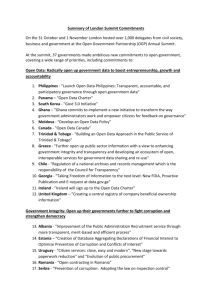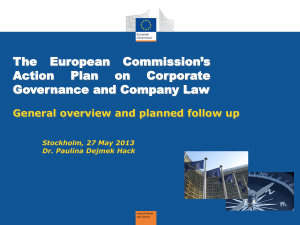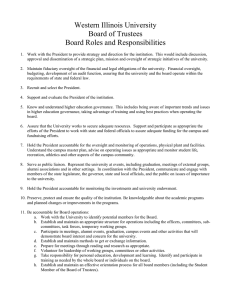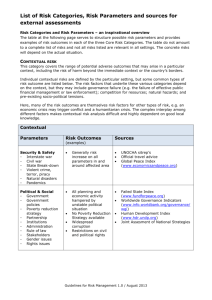Publishing Construction Contracts as a Tool for Efficiency and Good Governance Charles Kenny
advertisement
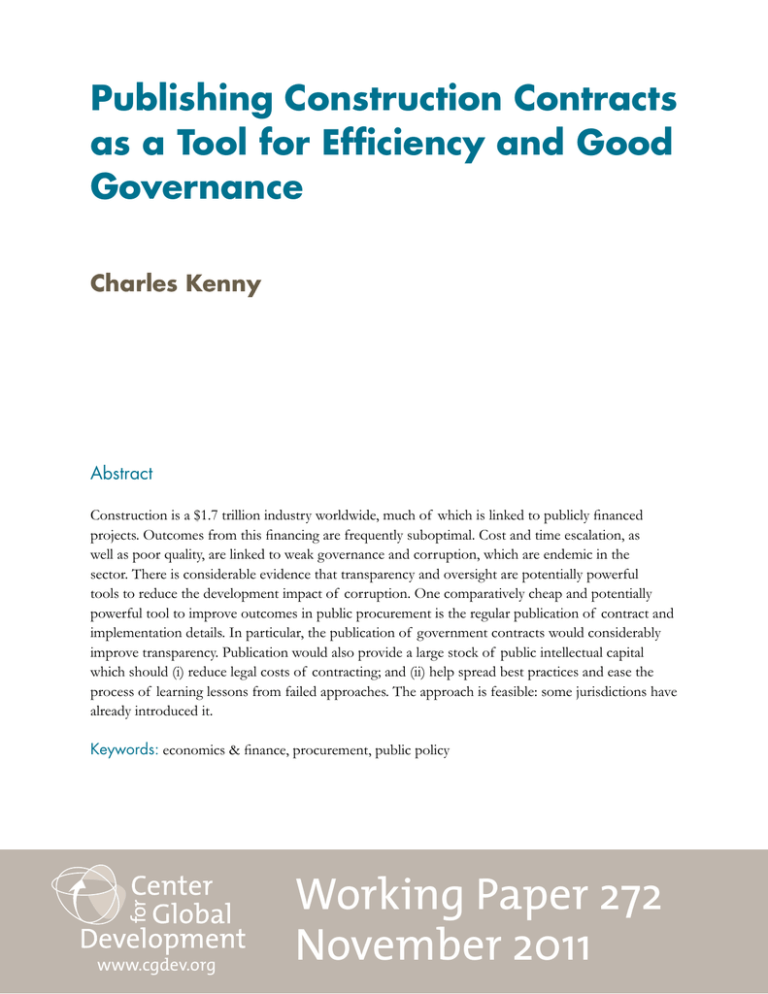
Publishing Construction Contracts as a Tool for Efficiency and Good Governance Charles Kenny Abstract Construction is a $1.7 trillion industry worldwide, much of which is linked to publicly financed projects. Outcomes from this financing are frequently suboptimal. Cost and time escalation, as well as poor quality, are linked to weak governance and corruption, which are endemic in the sector. There is considerable evidence that transparency and oversight are potentially powerful tools to reduce the development impact of corruption. One comparatively cheap and potentially powerful tool to improve outcomes in public procurement is the regular publication of contract and implementation details. In particular, the publication of government contracts would considerably improve transparency. Publication would also provide a large stock of public intellectual capital which should (i) reduce legal costs of contracting; and (ii) help spread best practices and ease the process of learning lessons from failed approaches. The approach is feasible: some jurisdictions have already introduced it. Keywords: economics & finance, procurement, public policy www.cgdev.org Working Paper 272 November 2011 Publishing Construction Contracts as a Tool for Efficiency and Good Governance Charles Kenny Center for Global Development ckenny@cgdev.org CGD is grateful for contributions from the UK Department for International Development in support of this work. Charles Kenny. 2011. “Publishing Construction Contracts as a Tool for Efficiency and Good Governance.” CGD Working Paper 272. Washington, D.C.: Center for Global Development. http://www.cgdev.org/content/publications/detail/1425688 Center for Global Development 1800 Massachusetts Ave., NW Washington, DC 20036 202.416.4000 (f ) 202.416.4050 www.cgdev.org The Center for Global Development is an independent, nonprofit policy research organization dedicated to reducing global poverty and inequality and to making globalization work for the poor. Use and dissemination of this Working Paper is encouraged; however, reproduced copies may not be used for commercial purposes. Further usage is permitted under the terms of the Creative Commons License. The views expressed in CGD Working Papers are those of the authors and should not be attributed to the board of directors or funders of the Center for Global Development. Introduction Poor governance in public construction is a considerable development issue. Governance failures can lead to the construction of the wrong infrastructure, poor quality construction and excessively high prices for work. There is some evidence from both other sectors and the construction sector itself that improved transparency, especially when combined with oversight, can improve development outcomes through its impact on the quality of governance. This paper reviews that evidence, discusses costs and benefits of greater transparency in particular with regard to the contracting and delivery process in construction, and briefly discusses an initiative to improve governance in public construction –the Construction Sector Transparency Initiative. Mismanagement, Corruption and Development Outcomes in Construction A justification for greater transparency and oversight in publicly-financed construction should start with an elaboration of the problem to be addressed. That problem is one of poor outcomes in a large sector that is central to development. Construction is a $1.7 trillion industry worldwide, much of which is linked to publicly financed projects. Government investment in road transport alone can account for between 2-3.5% of GDP. Outcomes from this financing are frequently sub-optimal. In India, for example, nearly half of all roads projects see cost overruns greater than 25 percent, and more than half see delays adding fifty percent or more to completion times (World Bank, 2007). The quality of infrastructure constructed can also leave much to be desired. Press reports suggest that an Indian government survey of a recent rural roads project found one fifth of completed roads to be unsatisfactory (igovernment, 2007). Similar statistics can be found around the world – for example, a global survey suggests that “substantial cost escalation is the rule rather than the exception” in infrastructure projects estimating that for rail projects, average cost escalation is 45%, for fixed links (tunnels and bridges) it is 34% and for roads, 20% (Flyvbjerg, Holm and Buhl, 2003). 1 Some of this cost and time escalation, as well as poor quality, are linked to weak governance and corruption, which are endemic in the sector. Construction ranks as the most corrupt industry in global surveys (Kenny, 2009). Construction firms represented in the Business Environment and Enterprise Performance Survey of Eastern Europe and Central Asia have significantly larger ‘bribe budgets’ than the average firm, and they bribe more often. Of their total bribe budget, a larger percentage goes to gain government contracts –an average of 23 percent for construction compared to 15 percent for all firms in the sample. Construction firms in Eastern Europe believe that a typical payoff made for securing a government contract in their industry is around seven percent of the contract value (Kenny, 2009). Lower reported bribes payments are associated with lower costs. Costs for road rehabilitation are higher in countries where the average bribe paid for government contracts is larger. The average cost paid per square meter for rehabilitation of a two-lane road between 6-8 meters wide with a bituminous surface across eighteen countries for which we have good data on both bribes and costs was $36. In countries where the average bribe for a government contract was reported to be below two percent of the contract value, this cost was $30. For countries where bribes for government contracts were reported to be larger than two percent of their value, average costs were $46. (Data on road costs from World Bank, 2010a, data on bribes from World Bank 2010b, for full details see Kenny, 2010). Corruption and mismanagement have been repeatedly linked to reduced construction quality, as firms skimp on work and materials while bribing officials to look the other way. Examples uncovered in investigations of corruption in World Bank Group projects include roads built to lower standards or narrower width, buildings constructed with inadequate reinforcing or honeycombed concrete –and buildings not built at all. Again, while the World Bank financed Kecamatan Development Project in Indonesia delivered some impressive outcomes, one estimate based on a physical survey of road materials is that about 24 percent of expenditures in road construction under the project were ‘lost’ (Olken, 2007). Low quality construction related to corruption can dramatically reduce infrastructure life spans –by one half or more. One estimate is that a dollar’s worth of materials skimped in road projects to finance corrupt payments reduces the economic benefit of the road by $3.41 as a result of its impact on quality and lifespan (Olken, 2007). Significant social costs can also be involved. In 1999, more than half of all buildings in Turkey failed to comply with construction regulations, even though 98 percent of the country's population lives in earthquake-prone zones. One result of this evasion was a considerable number of avoidable fatalities in the 1999 earthquake –11,000 people died. Allegations regarding school collapse related to corruption have also emerged in the aftermath of the 2008 Sichuan earthquake in China (Hui, 2009). 2 The Role for Greater Transparency and Oversight The current procurement and oversight systems of governments and donor partners are, of course, designed to reduce the impact of governance failure. That some of the examples of failure above were drawn from donor-financed government projects is evidence that existing procurement and oversight regimes may not always be enough to deter corruption. As further evidence, a recent survey of firms that bid on international contracts found that only fifteen percent of respondents thought that tender rules were an obstacle to corruption (Soreide, 2006). Furthermore, procurement systems alone can never be enough to ensure quality delivery. The most competitive procurement based on the strongest designs can offer little defense against the lowest bidder skimping on delivery and bribing to cover up shoddy work. Indeed, Gresham’s law (‘bad money drives out good’) can apply to lowest-cost procurement outcomes when we cannot or do not measure quality. Good contractors bid a reasonable price. Bad contractors can bid low despite the fact that work cannot be completed to standard at that price. If we fail to monitor outcomes, such firms can get away with delivering poor quality. There is considerable evidence that (additional) transparency and oversight are potentially powerful tools to reduce the development impact of corruption. Not least, this is strongly suggested by World Bank financed project outcomes in environments where transparency and oversight are allowed to work. World Bank projects in countries with the strongest protection of civil rights generate economic rates of return 8-22 percentage points higher than projects in countries with the weakest civil rights (the mean rate of return is 16 percent). There is suggestive evidence that the route for this impact is from civil liberties through citizen voice and government accountability to greater efficiency in government service provision (Isham et. al., 1997, Isham et. al., 1994, Dollar and Levin, 2005). Specific to construction, evidence on road costs and political rights suggests greater ability to effect change on government contracts can improve outcomes. Kaufmann and Kraay’s ‘Voice and Accountability’ indicator measures the extent to which a country’s citizens are able to participate in selecting their government, as well as freedom of expression, freedom of association, and a free media. Data from World Bank financed roads contracts in 28 countries suggests that those countries which see above average voice and accountability pay $30 per square meter for rehabilitation of a two lane highway compared to $37 in countries with low voice and accountability. Separate data on cost overruns from 130 World Bank financed road projects in 24 countries suggests that countries with voice and accountability scores below the global average see average cost overruns of 46%. This compares to countries with above average voice and accountability, which see cost overruns of only 18%. (Data on road costs from World Bank, 2010a, data on voice and accountability from Kaufmann, Kraay and Mastruzzi, 2009, for full details see Kenny, 2010). 3 Project-level experience provides further evidence in support of the impact of transparency and oversight on outcomes. Despite considerable evidence of losses to corruption described above, the Indonesia Kecamatan Development Project involved close local (beneficiary) oversight produced savings of between 25 to 56 percent over conventional infrastructure projects (Wong and Guggenheim, 2005). In Bangladesh, a study of community oversight of infrastructure projects suggested that costs and completion times were more than 25 percent lower while asset life was four times longer on such projects compared to standard approaches (GHK et. al. 2004). Regarding post-procurement oversight of projects in particular, work by the Concerned Citizens of Abra for Good Governance in the Philippines performing quality checks on public procurement projects has, inter alia, led to a remove and replace order for portions of a highway project and seen the conviction of eleven employees of the Department of Public Works and Highways. Again, as part of the Bali Urban Infrastructure Project, financed by the World Bank, a range of measures were put in place to strengthen contractor competition including engaging the association of contractors and civil society in a process of reform that increased transparency, established an effective complaints handling mechanism, and extended random checks and technical audits. Complaints received increased from fewer than ten per year prior to the project to greater than 200 in the project’s first full year. Prices charged for works and inputs under the project (concrete, excavation and road works) fell over the first three years, compared to considerable price increases for the same inputs and works in non-project contracts. Savings amounted to 21 percent of estimated costs (Soraya, 2009a). Limits to Transparency and Oversight Although there is clear micro evidence of the advantages to transparency and oversight mechanisms, we should also accept their limitations. Large-scale oversight mechanisms work best when stakeholders can directly and easily observe problems (Banerjee et al 2008). This may suggest the more appropriate oversight focus for any direct community oversight role. In road construction, for example, this might be to spot problems such as the lack of a road where one should be, one lane where there should be two, or potholes where there should be repairs. More broadly, in countries where functional literacy is comparatively rare, where access to information and communications tools such as the Internet is limited and where the press is controlled, the likelihood that civil society observers will be able to access and comprehend information on construction, or utilize that information to change outcomes, will be curtailed. A second feature worth noting is the considerable costs that can be associated with active transparency and oversight. The Indonesia Urban Poverty Program, financed by the World Bank, disburses about $100m a year to over 8,000 villages across Indonesia and provides one example of both benefits and costs. As part of the oversight mechanism, 100,000 elected volunteers serve as project overseers. In addition, a website records project details including 4 individual project details, implementation status, full consultant contracts, consultant invoices, status of disbursement and details on travel expenses related to the project and a complaint handling mechanism (Soraya, 2009b). The total of capacity building and oversight mechanisms is estimated at 13 percent of total project costs, or a little over $24m out of a $186m project. These costs are lower than the benefits frequently associated with oversight and transparency in community projects, and many are one-off expenditures associated with benefits that should outlast the life of the project –but they are still considerable. This suggests the possibility that measures to improve governance, much like other regulation designed to minimize market or government failure, can carry higher costs than the economic benefit of the reduced corruption that they are associated with (Olken, 2007). Publishing Contracts and Implementation Details With that caveat, one comparatively cheap and potentially powerful tool to improve outcomes in public procurement is the regular publication of contract and implementation details. In particular, the publication of government contracts would improve transparency (and so hopefully reduce corruption). There is a clear public interest in access to such documents as they involve distribution of public funds or publicly-controlled properties. Publication would also provide a large stock of public intellectual capital which should (i) reduce legal costs of contracting; and (ii) when combined with information on contract performance, help spread best practices and ease the process of learning lessons from failed approaches. Contracts specify what is to be delivered when, how, by whom and at what unit prices. As such, they contain a wealth of information about who will benefit from the contract, potential waste or padded prices, and what the project outputs should be. All of this information can be compared against original bid documents, information about implementation and final outputs to allow third parties to monitor procurements, awards and the efficacy of resource utilization. The potential benefits are clear. The ease and practicality of contract publication in particular is perhaps less so. At the same time, many governments also have laws on the books that grant public access to the majority of contracts on demand, and a few countries are already routinely publishing contract and implementation documentation. Contract and Implementation Details Publication to Date Whilst presumption of publication is still a comparative rarity, in many countries, Freedom of Information Acts (FOIAs) give citizens theoretical access to contracts. Nonetheless, FOIA requests are time consuming and can incur significant charges (for documents over 100 pages, review of material to ensure it can be released is charged at rates as high as $25 5 per hour in the US). Furthermore, requests are likely to face challenges from contracting companies filing ‘reverse’ freedom of information requests to limit or restrict disclosure (Corey, 2005). Furthermore, many countries lack FOIAs or see them weakly enforced. In short, while FOIAs suggest that contracts and implementation reports could be published, the better model is to proactively publish such information. Some countries have already taken steps towards this approach. Argentina publishes detailed information about contract awards and implementation, and Turkey publishes winning bids for government contracts. Colombia’s government e-procurement website allows a range of project documents to be viewed by the public online. For example, a $1.24 million project for the construction of a passenger terminal on river Barrancabermeja has 132 project documents available for review. These documents include: Draft Terms of Reference Definitive Terms of Reference Clarifications during the selection process Act from the Awarding Meeting Contract Contract Extensions and other modifications Evaluation Report By 2008, there were 99,455 transactions recorded and the site received an average of 453,402 visitors per month (World Bank, 2009). Again, the government of the Australian State of Victoria mandates full publication of all Victoria government contracts (including contract revisions) for contracts worth in excess of AUS$10m. In Victoria, exceptions are made for information in contracts that is genuinely a commercial secret the release of which would unreasonably disadvantage the contractor, or which it is against the public interest to disclose, guided by language in the state’s freedom of information act. The intent is to limit nondisclosure to the narrowest sections of the contract and for as short a time as is possible. Costs and Benefits of Systemic Full Publication of Contracts The argument against presumption of publication is usually one of cost related with redacting confidential information. In its deliberations, the Victoria (Australia) public accounts committee concluded that the insistence of confidentiality clauses in government contracts frequently came from the government, not the contractor, suggesting that fears 6 regarding the complexity of reviewing contracts for commercial secrets may be exaggerated (Victoria, Australia, 2000). Furthermore, it is difficult to see the significant public interest in restricting information regarding company information in contracts beyond those involving patentable (but unpatented) technology. That some countries are managing a process of routine proactive disclosure further suggests that it is administratively possible. With a suitable dollar cut-off level for automatic publication, it is likely that the review burden could be reduced while still ensuring the publication of contracts involving a considerable percentage of government financing. To extrapolate based on a developing country example, India sees around 5,000 $1m-plus contracts signed in the roads sector a year. Assuming India’s share of developing country road construction is about the same as its share of developing country national income, this suggests a little over 60,000 $1m-plus roads contracts in developing countries each year –or a little under an average of 400 per developing country. Road construction is probably the largest single government-financed construction activity worldwide. As a back of the envelope calculation, it might be expected that the average number of $1m-plus government financed construction contracts per developing country might be on the order of 2,000 per year. It is plausible to imagine significant financial savings to governments from contract publication in terms of reduced prices due to reductions in corrupt payments. Investment climate surveys suggest that bribe fees equal an average of about 3.2 percent of contract values–with sector-level estimates ranging considerably higher. Greater threat of scrutiny can lead to significant reductions in corruption. The threat of an audit reduced the level of corruption in Indonesian road projects by eight percent, for example (Olken, 2007). If contract and implementation detail publication reduced levels of corruption by only five percent, this suggests a reduction in bribe fees equal to 0.16 percent of total contract values, which is likely to be a multiple of the review costs involved in publishing these contracts. Furthermore, given that estimates for the total economic cost of corruption are considered to be as high as 15-50 percent of the funds involved (Jain, 2001), it appears clear that the economic benefits of publication may be considerably larger than the direct financial benefits to government in terms of contract outcomes. Once contracts have been published, barriers to the publication of a range of implementation documentation largely fall away. This suggests that with relatively little additional effort or expense one could routinely publish extensions, modifications and evaluation reports. The Construction Sector Transparency Initiative The Construction Sector Transparency (CoST) Initiative is a global initiative designed to support more widespread publication of construction contracts and implementation details. It is a partnership between governments, private sector and civil society, which aims to increase transparency and accountability in construction procurement. CoST requires public 7 disclosure of contracting, payment and oversight information regarding governmentfinanced construction projects. For some contracts, this information is validated and compared to outcomes on the ground. A multistakeholder group of civil society, government and private sector oversees the process of information release and validation. The core idea of CoST is “Get What You Pay For.” The premise of the initiative is that greater accountability and transparency will reduce costs and improve the quality of government-financed construction. CoST is designed to regularize publication of the following list of contract details: (i) identification details related to the contract, including project specification, purpose, location, intended beneficiaries, and feasibility study; (ii) project funding related to the contract, including financing agreement; (iii) tender process details including a list of tenderers and the tender evaluation report; (iv) award details including contractor name, contract price, contract scope of work and contract program; (v) contract execution details including individual significant changes to the contract which affect the price and reasons for those changes, individual significant changes to the contract which affect the program and duration and reasons for those changes, and details of any re-award of main contract; and (vi) post completion details including contractor name, actual contract price, final contract payment, actual contract scope of work, actual contract program and project evaluation report. CoST has been piloted in seven countries (Tanzania, Zambia, Malawi, Vietnam, the Philippines, Ethiopia and the UK). The pilot stage has demonstrated the feasibility of publication and the utility of multi-stakeholder oversight of the process. At the same time, it has highlighted the need for considerable government leadership and capacity with regard to publication. If existing management information systems within agencies do not regularly collect the type of information to be released by CoST, preferably electronically, publication can carry reasonably large transactions costs. Without government commitment, these costs are unlikely to be met. Even in cases where existing management information systems are strong, the commitment to publication carries with it the burden of responding to additional oversight and potential complaints. Conclusion As a vital activity for development and one that frequently falls victim to failures of governance, publicly-financed construction could benefit considerably from improved oversight. One tool to provide such oversight uses transparency in contracting and implementation to improve the capacity of citizens and beneficiaries to ensure that they are getting what they paid for from projects and contracts. The Construction Sector Transparency Initiative, building on the experience and success of countries such as Colombia in publishing contracting details, provides a model for improving transparency and oversight in the sector, as well as demonstrating the key importance of government commitment to leading reform. 8 Bibliography Banerjee, A., R. Banerji, E. Duflo, R. Glennerster and S. Khemani (2008) Pitfalls of Participatory Programs: Evidence from a Randomized Evaluation in Education in India World Bank Policy Research Working Paper 4584. Corey, T. (2005) Freedom of Information: Protecting Commercial Information in the Information Age, mimeo, Steptoe and Johnson, New York. Dollar, D. and V. Levin (2005) Sowing and Reaping: Institutional Quality and Project Outcomes in Developing Countries World Bank Policy Research Working Paper 3524 Flyvbjerg, B. M. Holm and S. Buhl (2003) How common and how large are cost overruns in transport infrastructure projects? Transport Reviews 23(1):71-88 GHK, ADB, ADI and UNCDF (2004) Local Governance and Service Delivery to the Poor, A Bangladesh Case Study. Hui, D. (2009) Politics of Sichuan Earthquake, 2008, Journal of Contingencies and Crisis Management, 17, 2. igovernment (2007) Conditions of India’s Rural Roads ‘Unsatisfactory,’ http://www.igovernment.in/site/condition-of-indias-rural-roads-found-unsatisfactory/, accessed 09/15/2011 Isham, J., D. Kaufmann and L. Pritchett (1997) Civil Liberties, Democracy and the Performance of Government Projects World Bank Economic Review 11, 2. Isham, J., D. Narayan and L. Pritchett (1994) Does Participation Improve Project Performance? World Bank Policy Research Working Paper 1357. Jain, A. (2001) Corruption: a Review Journal of Economic Surveys 15,1. Kaufmann, D., A. Kraay and M. Mastruzzi (2009) Governance Matters VIII: Governance Indicators for 1996-2008 World Bank Policy Research June 2009 Kenny, C. (2009) Measuring and Reducing the Impact of Corruption in Infrastructure Journal of Development Studies forthcoming Kenny, C. (2010) Publishing Construction Contracts and Outcome Details, World Bank Policy Research Working Paper 5247. Olken, B. (2007) Monitoring Corruption: Evidence from a Field Experiment in Indonesia, Journal of Political Economy 115, 2. Soraya, G. (2009a) Indonesian Experience Governance and Anticorruption Bali Urban Infrastructure Project (BUIP) presentation to the World Bank GAC in Projects Group, 4/21/09 Soraya, G. (2009b) Risk Mitigation of Leakage in UPP, presentation to the World Bank GAC in Projects Group, 4/21/09 Soreide T. (2006) Procurement Procedures and the Size of Firms in Infrastructure Contracts Paper Prepared for the World Bank Annual Conference on Development Economics, Tokyo 29-30 May. Victoria (Australia) Public Accounts and Estimates Committee Inquiry into Commercial in Confidence Material and the Public Interest (35th Report to Parliament, March 2000). 9 Wong, S. and S. Guggenheim (2005) Community-Driven Development: Decentralization's Accountability Challenge in World Bank (ed) East Asia Decentralizes: Making Local Government Work World Bank: Washington DC. World Bank (2007) Indian Road Construction Industry: Ready for Growth? mimeo, South Asia Regional Transport Team. World Bank (2009) Publishing Information on Public Construction Projects, mimeo, World Bank. World Bank (2010a) ROCKS database http://web.worldbank.org/WBSITE/EXTERNAL/TOPICS/EXTTRANSPORT/EX TROADSHIGHWAYS/0,,contentMDK:20485235~menuPK:1097394~pagePK:14895 6~piPK:216618~theSitePK:338661~isCURL:Y,00.html, accessed 3/1/2010 World Bank (2010b) Enterprise Surveys database, http://www.enterprisesurveys.org/, accessed 3/1/2010. 10

